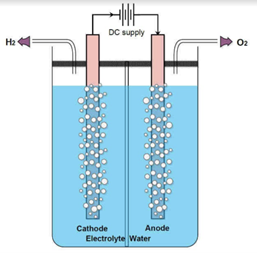
The role of bubble formation in sustainable hydrogen production
The sustainable production of hydrogen could potentially be made more efficient by adding a cleverly chosen salt to the process. Researchers at the Leiden Institute of Chemistry (LIC), in collaboration with physicists at the University of Twente, have discovered that the type of salt present in the production of hydrogen through electrolysis affects the formation of hydrogen bubbles. This is interesting because bubble formation affects the efficiency of hydrogen production.
Sustainable hydrogen production is going to play an important role in the energy transition. Hydrogen is a CO2-free energy carrier and a raw material for fertilisers, for example. ‘A sustainable way to make hydrogen is through electrolysis,’ says Marc Koper, professor of Catalysis and Surface Chemistry.

What is it? Electrolysis
In electrolysis, water (H2O) is converted into hydrogen (H2) gas and oxygen (H2) gas via an electrochemical reaction. To do this, you place two electrodes in water in which salt is dissolved. The salt provides good electrical conductivity. As soon as you apply an electrical voltage to the electrodes, bubbles of hydrogen gas form at one electrode and oxygen bubbles at the other.
Photo credits: International Journal of Engineering and Advanced Technology (IJEAT)
Why do we want small bubbles?
Koper and his colleagues investigated how the hydrogen bubbles form and detach from the electrode. Their research appeared in the journal Nature Chemistry. ‘You want small bubbles to form that stick to the electrode surface for as short a time as possible,’ explains Koper. ‘This is because the bubbles act as insulators, making the electrolysis cell less conductive, causing a less efficient production of hydrogen.
A carpet of small bubbles
For the study, the scientists used an electrode about 0.1 millimetres in size, on which exactly one bubble could form. ‘This allowed us to study the behaviour of a single bubble with different types of salt,’ says postdoc Sunghak Park.
Advanced cameras of the Twente research group of Detlef Lohse and Dominik Krug, carefully recorded the behaviour of the bubbles. It turned out that instead of one separate bubble, a carpet of smaller bubbles is formed, with the larger bubble on top that is being fed by the smaller ones.
Type of salt influences bubble formation
But that was not the biggest surprise. How the smaller bubbles feed the larger one and when that larger bubble leaves the surface of the electrode turned out to depend heavily on the salt used. ‘That had not been observed before,’ says Koper.
Salt consists of two different charged particles (ions): positively charged cations and negatively charged anions. The anion in particular was found to influence bubble formation. With the sulphate anion, small bubbles easily formed a large bubble, while with the perchlorate anion, mainly small bubbles formed, which were quickly released.
What does wine tasting have to do with electrolysis?
The researchers found that this is due to the Marangoni effect, which also causes wine legs or ‘tears’. The Marangoni effect a fluid flow is created due to a concentration or density difference. In electrolysis, hydrogen production causes a difference in anion concentration at the electrode, creating a similar fluid flow there. The direction of that flow depends on the type of anion. For sulphate, the flow pushes the bubbles downwards, against the electrode. As a result, the large bubble grows and sticks in place longer. With perchlorate, the flow pushes the bubbles away from the electrode, preventing them from forming a larger bubble. This results in a faster release of small bubbles from the surface.
Making commercial electrolysis more efficient
‘That this mechanism plays a role in bubble formation was not known,’ says Koper. ‘It’s interesting because it means we could control bubble behaviour by adding the right salts.’ Future research will have to show whether this can make commercial electrolysis more efficient.
